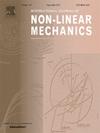Linear stability of Navier–Stokes–Voigt fluid under the influence of uniform magnetic field in a porous medium
IF 3.2
3区 工程技术
Q2 MECHANICS
International Journal of Non-Linear Mechanics
Pub Date : 2025-04-10
DOI:10.1016/j.ijnonlinmec.2025.105105
引用次数: 0
Abstract
We analyze the instability of plane Poiseuille flow for a viscoelastic Navier–Stokes–Voigt fluid influenced by a vertical magnetic field within a homogeneous porous medium. The viscoelastic fluid, confined between two parallel plates, is driven by a pressure gradient. To examine the effects of the Voigt parameter , permeability , and Hartmann number on flow stability, we numerically solve the generalized eigenvalue problem using the Chebyshev spectral collocation method, which provides an accurate upper bound for stability. For the set of parameters, the plane Poiseuille flow of the Navier–Stokes–Voigt fluid stabilizes as and increase, preserving the Newtonian eigenspectrum within a specific range of , , and . The eigenspectra display a characteristic -shaped structure with three distinct modes, depending on the phase speed. The instability consistently emerges in the wall mode for the physical parameters , , and . The transition from laminar flow to turbulence is identified at a Reynolds number and a disturbance wavenumber in the case of channel Poiseuille flow of a Newtonian fluid and this is termed as Tollmien–Schlichting instability. The neutral stability curves corresponding to different values of , , and extend the Tollmien–Schlichting instability observed in Newtonian channel flow. Stability regions expand with increasing , , and , as demonstrated by the neutral stability diagrams obtained for various associated parameters. Furthermore, the energy budget method is employed to validate our findings by quantifying the physical mechanisms driving instability. While Reynolds stress leads to negative energy production, viscous dissipation and viscoelastic contributions positively influence energy production, ultimately reducing the kinetic energy growth rate and enhancing stability.
均匀磁场影响下多孔介质中Navier-Stokes-Voigt流体的线性稳定性
本文分析了均匀多孔介质中受垂直磁场影响的粘弹性Navier-Stokes-Voigt流体平面泊泽维尔流的不稳定性。粘弹性流体被限制在两个平行板之间,由压力梯度驱动。为了研究Voigt参数Λ、渗透率Ω和Hartmann数Ha对流动稳定性的影响,我们使用Chebyshev谱配点法数值求解广义特征值问题,该方法提供了一个精确的稳定性上界。对于参数集,Navier-Stokes-Voigt流体的平面泊泽维尔流随着Ω和Ha的增加趋于稳定,在Λ、Ω和Ha的特定范围内保持牛顿特征谱。特征谱随相速的变化呈现出具有三种不同模式的特征y型结构。对于物理参数Λ、Ω和Ha,壁面模式的不稳定性一致。从层流到湍流的过渡在雷诺数Re=5772.22和扰动波数a=1.02时被确定,这被称为托尔米恩-施里希亭不稳定性。不同Λ、Ω和Ha值对应的中性稳定性曲线扩展了牛顿通道流中Tollmien-Schlichting不稳定性。稳定性区域随着Λ、Ω和Ha的增加而扩大,从各种相关参数的中性稳定性图中可以看出。此外,能量收支法通过量化驱动不稳定性的物理机制来验证我们的发现。雷诺应力导致负能量产生,而粘滞耗散和粘弹性贡献对能量产生积极影响,最终降低了动能增长率,增强了稳定性。
本文章由计算机程序翻译,如有差异,请以英文原文为准。
求助全文
约1分钟内获得全文
求助全文
来源期刊
CiteScore
5.50
自引率
9.40%
发文量
192
审稿时长
67 days
期刊介绍:
The International Journal of Non-Linear Mechanics provides a specific medium for dissemination of high-quality research results in the various areas of theoretical, applied, and experimental mechanics of solids, fluids, structures, and systems where the phenomena are inherently non-linear.
The journal brings together original results in non-linear problems in elasticity, plasticity, dynamics, vibrations, wave-propagation, rheology, fluid-structure interaction systems, stability, biomechanics, micro- and nano-structures, materials, metamaterials, and in other diverse areas.
Papers may be analytical, computational or experimental in nature. Treatments of non-linear differential equations wherein solutions and properties of solutions are emphasized but physical aspects are not adequately relevant, will not be considered for possible publication. Both deterministic and stochastic approaches are fostered. Contributions pertaining to both established and emerging fields are encouraged.

 求助内容:
求助内容: 应助结果提醒方式:
应助结果提醒方式:


